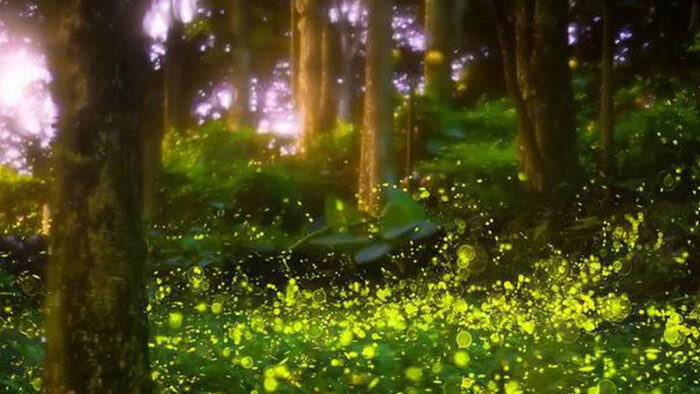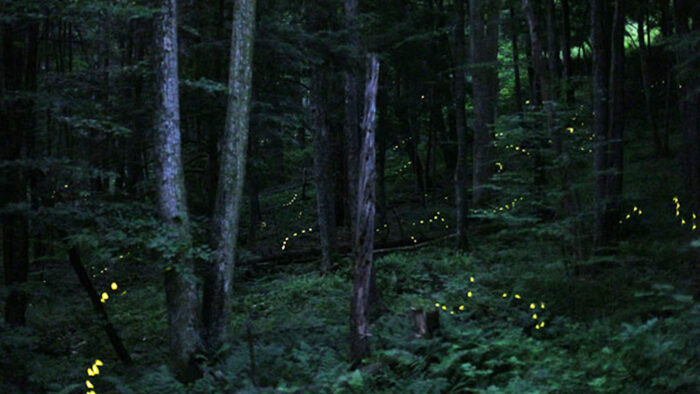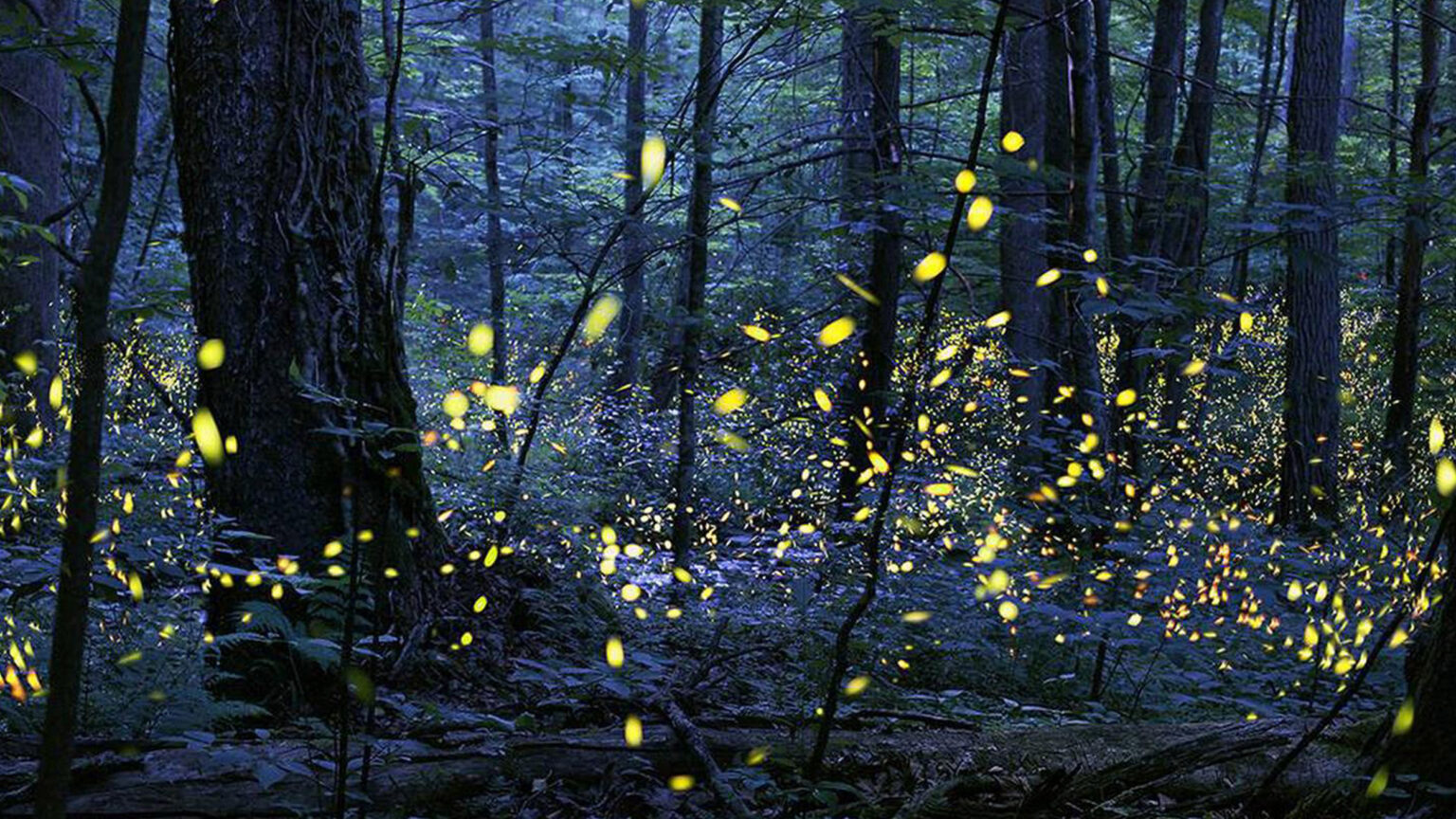Fireflies. Lightning bugs. Whatever you call the little beetles, they’re a beautiful evening spectacle — illuminating the dusky woodlands with a spectral and fleeting glow all their own.
Over 2,000 species of fireflies light up the world, but they are particularly prevalent in the dense forests of North America, which 170 varieties call home. And once per year, for a few weeks in late May and early June, one particular species does something special. While most North American species of fireflies flash individually, the males of the Photinus carolinus firefly have a different approach.
They synchronize, bringing stunning bursts of simultaneous yellow-gold light to the air above the forest floor of one of the oldest mountain ranges in the world.

Photo: Shutterstock
Photinus carolinus is a firefly native to the southeastern and mid-Atlantic regions of the United States. Their population in the Great Smoky Mountains, a range that straddles the U.S. states of Tennesee and North Carolina, is particularly dense. It was here, in the southern Appalachian Mountains, that the glaciers stopped advancing at the end of the last Ice Age.
Stayed after the glaciers retreated
As the glaciers retreated, many of the species the oncoming walls of ice had pushed southwards stayed put. The result is an incredibly biodiverse area boasting one of the continent’s most varied blends of plant, animal, and fungal species.
P. carolinus is one such species.
While it’s certain that the Cherokee people who lived in the rich, green landscape for thousands of years knew about the synchronous displays — as did the white settlers who displaced them — the interesting evolutionary tactic wasn’t described by science until the 1990s.

The Great Smoky Mountains are one of the world’s oldest mountain ranges. Now topping out at 1,800m, they used to be taller than the Himalaya. Photo: Shutterstock
That’s when a citizen naturalist named Lynn Frierson Faust read a science news magazine article claiming that synchronous fireflies didn’t exist in the western hemisphere. (Some species synchronize in Asia.)
“Growing up in east Tennessee, we called them lightning bugs. They’re just part of summer,” Faust told NPR. “I thought, ‘Ours are synchronous – who do I tell this to?’”
After writing letters to biologists and other researchers, word got out to the scientific community at large. Having studied P. carolinus for 30 years, scientists now believe they know why the little beetles arrange their nightly light show the way they do. But as for the how? Like the best parts of our world, that’s still a mystery waiting for an answer.
Standing out from the crowd
The Smoky Mountain population of P. carolinus spends one to two years in the larval stage, feeding on the many worms and snails that slime their way through the wet forest floor of the temperate rainforest. Then, they grow wings and emerge to mate.
So far, P. carolinus is no different than the thousands of other lightning bug species around the world. They also share their cousins’ method of illumination — bioluminescence.
According to the National Park Service, “fireflies combine the chemical luciferin and oxygen with the enzyme luciferase in their lanterns (part of their abdomens) to make light.” The result is a reaction that’s nearly 100% light, with nearly nothing wasted as heat.
“In contrast,” the NPS continues, “the energy produced by an incandescent light bulb is approximately 10% light and 90% heat.” Male fireflies buzz around while flashing, while females hover in one place and flash in response.

The P. carolinus firefly. If you had a lantern in your abdomen, you’d want it to produce almost zero heat as well. Photo: National Park Service
For fireflies, the mating window is short
The mating window is short — so short that many don’t even stop to eat once they emerge — only one to two weeks. And a ticking clock isn’t the only thing they have to contend with.
The problem is light pollution, but not in the way you may be thinking. There are 18 other species of fireflies in the park, and a good deal of them are blinking at the same time. Some of them are even predatory and use their blinks to lure in competing species for a tasty snack.
If you are a single person trying to stand out on the world’s many dating apps, you might find yourself sympathizing with the conundrum.
So P. carolinus evolved a novel solution. The males synchronize their flashes, all the better to catch the attention of females who might otherwise be confused by light displays from males of different species.
The display is spectacular — five to eight flashes followed by an eight-second pause, then five to eight flashes. As dusk falls, the flashes start out randomly, but as more and more males join in, the pattern syncs, and the show truly begins.
It’s a strategy that only benefits some of the thousands of P. carolinus males who emerge every spring. But some is better than none, and from a species perspective, it’s worked so far.
Unanswered questions
While the lens of evolution provides a plausible explanation for the behavior, biologists still aren’t entirely clear on how lightning bugs like P. carolinus synchronize their flashes. But the fact that the display starts out randomly and then synchronizes over time might provide an answer.
Orit Peleg, a biophysicist and computer scientist at the University of Colorado in Boulder, told NPR that she believes the trigger is visual, not biochemical or auditory.
“We can actually trigger that communication with an artificial LED light,” she said.
Even more intriguing, research has indicated that different parts of a P. carolinus swarm can initiate synchronicity on different evenings — basically, there aren’t specific male members of the group in charge of creating the display.

This display only occurs a few weeks a year, in May and June. Photo: National Park Service
Luckily for you and me, there’s no need to understand precisely how this particular natural wonder works in order to enjoy it. And you don’t even have to live in Western North Carolina or East Tennessee to see the display. P. carolinus’ range extends northward to Pennsylvania, although the beetles prefer the elevations and climate in the Great Smoky Mountains. And another synchronous species, Photuris frontalis, calls South Carolina’s Congaree National Park home.
Controlling visitors
To help preserve human impact on the unique species, managers at Great Smoky Mountain National Park and Congaree National Park have instituted a lottery system to help manage visitor traffic during the few precious weeks when the fireflies’ display is active. But if you don’t make the cut and happen to live in the Southeastern United States, you may still catch a glimpse.

Photo: Radim Schreiber/Wikimedia Commons
To maximize your chances, avoid treating your lawn with pesticides, leave some “wild spaces” in your yard, and eliminate outdoor lighting. Then kick back and enjoy the show. You may not see P. carolinus or P. frontalis doing their luminous dance, but you still have a good chance of catching one of the other 170 species of firefly that call North America home.
The displays usually only last 20 minutes or so, and you have to be in the right place at the right time. But sometimes, the fleeting nature of a natural wonder is what makes it all the more special.






